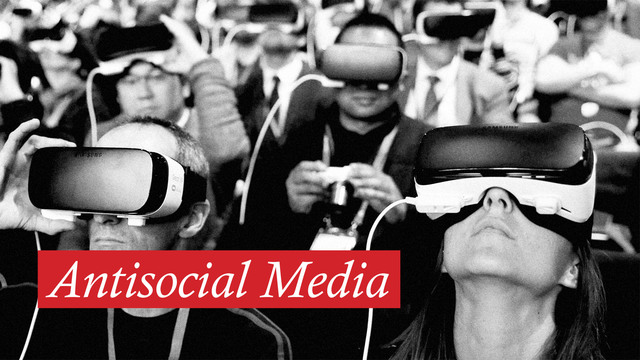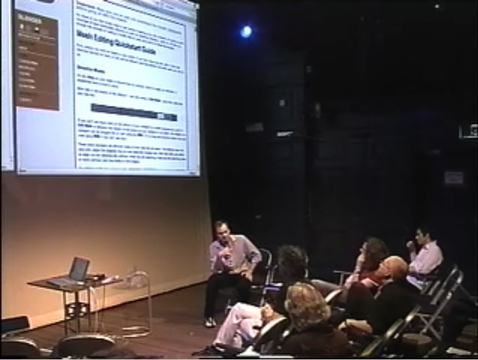Search results for 'interactive media'
The Network of Waves
Public Agency in Hybrid Space
Lead-essay for the theme issue "Hybrid Space" of OPEN, Journal for Art and the Public Domain, #11, (Amsterdam / Rotterdam, 2006).
DeeDee Halleck
DeeDee Halleck is a media activist and co-founder of Paper Tiger Television and the Deep Dish Satellite Network, the first grass roots community television network. She is Professor Emerita in the Department of Communication at the University of California at San Diego. Her filmography includes films like Children Make Movies( 1961), or Mural on Our Street, which was nominated for Academy Award in 1965. She has led media workshops with elementary school children, reform school youth and migrant farmers.
ReadTandem Surfing the Third Wave: Part 3
This interview was conducted between subRosa and Ryan Griffis via email correspondence during the first half of 2003.
Donatella DellaRatta
Donatella Della Ratta is a PhD fellow at the Department of Cross-Cultural and Regional Studies, New Islamic Public Sphere Program, Copenhagen University and at the Danish Institute in Damascus.
ReadNina Meilof
Nina Meilof is an multi media advisor and an independent producer TV and
internet programmes. Beside other projects, she worked for Amsterdam
The Digital City and is an editor of Digital Citizen.
McKenzie Wark
Australian media theorist and writer, currently lives and works in
New York. McKenzie Wark grew up and studied in Australia, at Macquarie University, the University of Technology, Sydney and at the Murdoch University. In 2000, he emigrated to the US.
How to Turn Your Liability into an Asset: Media, Art and Politics in Post-communist Bulgaria
The first interview was conducted during the opening of Hybrid Workspace in June 1997, the temporary media lab in the margins of the big art show Documenta X in Kassel (Germany).
ReadSpeed and Information: Cyberspace Alarm!
The twin phenomena of immediacy and of instantaneity are presently oneof the most pressing problems confronting political and militarystrategists alike. Real time now prevails above both real space and thegeosphere. The primacy of real time, of immediacy, over and above spaceand surface is a ~fait accompli~ and has inaugural value (ushers a newepoch). Something nicely conjured up in a (French) advertisementpraising cellular phones with the words: "Planet Earth has never beenthis small". This is a very dramatic moment in our relation with theworld and for our vision of the world.
ReadGrundrisse einer Netzkritik
1. Toward a European Standard Code for Critical Interchange (ESCCI)
Bezeichnen wir das Internet einfach einmal als 'Kind der Moderne', soist das klassische Genre der Kritik sicherlich ein Teil davon. Im nochandauernden Zeitalter des multikulturellen Massenkonformismus, vollerMikropraxis und Ich-Management, ist die Kunst der Kritik jedoch inVergessenheit geraten. Die hiesigen Kommentare zielen nur noch aufKorrektur von Verhaltensweisen ab. Die Meinungsmacher/innen haben allesAngebotene laengst hinter sich, sie sehen das Ganze wirklichdifferenziert, aus sicherem Abstand. Die glueckliche Tatsache, man seieben nicht engagiert, wird als persoenliche Errungenschaft gefeiert.Solche talking heads ohne Eigenschaften sind aber nutzlos in Zeitenrascher Entwicklungen, sowie das beim Wachstum der Computernetze imMoment der Fall ist.
Clemens Apprich
Theorist, writer, and Research Fellow at the Moving Image Lab as well as coordinator and curator at the Post-Media Lab at Leuphana University in Lüneburg.
ReadGovernmentality of Information
The American military network ARPAnet was conceived as a way to maintain uninterrupted communications in the event of nuclear war. Ancestor of the Internet and foundation of the Global Information Infrastructure, ARPAnet springs from exactly the same source as the "pushbutton war" that lay behind it: the change of scale provoked by the early 20th century discoveries in physics, within an industrial society capable of organizing the productivity - including the scientific productivity - of thousands of agents. Here, no doubt, is the real birthplace of the information society: a society massively penetrated by the sciences and technologies of information and telecommunications, using them to carry out the design of the planet or at least, that of its components (with design replacing politics). A society whose governmentality entails the knowledge of the real, that is to say, the transformation of reality into information. A society whose governmentality unfolds between its smallest common denominators (atomic, electronic, magnetic, genetic, chemical) and its largest common denominators (climate, planet, solar system), by way of laws, formulas and norms that determine its productivity, means, and possible destinies.
ReadRita Raley
Rita Raley is Associate Professor of English, with courtesy appointments in Film and Media Studies, Comparative Literature, and Global Studies at the University of California Santa Barbara. Her primary research interests lie at the intersection of digital media and humanist inquiry, with a particular emphasis on cultural critique, artistic practices, and language (codework, machine translation, electronic literature, and electronic English).
Cartography of Excess
Utopian ideas - like "Spaceship Earth" - are round, multidimensional, interrelated: their archetypal map is the Milky Way, the infinite constellations. But rational thinking is instrumental, linear, it distorts: and that's exactly the problem with the Mercator map, the most common world projection. Buckminster Fuller, inventor of the geodesic dome, created a "Dymaxion map" to undo those distortions. First the earth becomes a geometric figure, an isocahedron: its 20 triangles are then disjointed and laid flat, so the land masses radiate from a nexus in the north, without splitting continents or enlarging the polar regions.
Dawn of the Organised Networks
At first glance the concept of "organised networks" appears oxymoronic. In technical terms, all networks are organised. There are founders, administrators, moderators and active members who all take up roles. Think also back to the early work on cybernetics and the "second order" cybernetics of Bateson and others. Networks consist of mobile relations whose arrangement at any particular time is shaped by the "constitutive outside" of feedback or noise.[1] The order of networks is made up of a continuum of relations governed by interests, passions, affects and pragmatic necessities of different actors. The network of relations is never static, but this is not to be mistaken for some kind of perpetual fluidity. Ephemerality is not a condition to celebrate for those wishing to function as political agents.
Read





